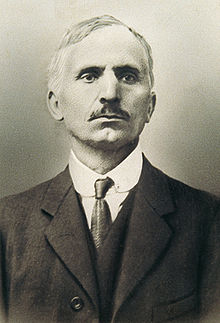Marius Borgeaud
Marius Etienne François Borgeaud (born September 21, 1861 in Lausanne , † July 16, 1924 in Paris ) was a Swiss painter.
Life
Marius Borgeaud was born into an upper-class family. His father Charles Eugène Louis Borgeaud (1825–1889) lived as a privateer . His mother was Suzanne Anna Borgeaud, née De Trey. Bougeaud was distantly related to the painter Félix Vallotton and his brother, his schoolmate and future art dealer Paul Vallotton . The family came from Pully . From 1874 he grew up in a Lausanne town house on Avenue de Rumine 2 (now number 3) that belonged to his father. He had an older brother, the future doctor Eugène François Louis Borgeaud (1855-1939), and a younger sister, Louise Marie Emma Borgeaud (1864-1906), both later married into the influential local bourgeoisie .
There are contradicting statements about the artist's youth. Borgeaud attended the industrial school on the Place de Riponne in Lausanne. Around 1873 or 1882 he did a commercial apprenticeship at a bank in Marseilles . For a short time he lived with his cousin Paul Borgeaud in Algiers , who worked there as a consul and businessman. His father died in 1889. Thanks to the preserved inheritance, Borgeaud was able to live carefree and quite unhealthy and wasteful in Paris for ten years. He was then placed under the tutelage of his cousin Auguste Regamey. After a spa stay around 1900 on Lake Constance , Borgeaud returned to Paris and decided to become a painter. From 1901 to 1903 he attended the painting schools of Fernand Cormon and Ferdinand Humbert . The Swiss artist colony was numerous, and Félix Vallotton was one of its members. Borgeaud joined the Paris section of the Association of Swiss Painters and Architects in 1906. With Edouard Morerod and Francis Picabia , he was looking for motifs while staying in the country. In Paris he lived in the 9th arrondissement , Cité Condorcet 9.
His early works were influenced by impressionism . In the summer months he visited Moret-sur-Loing in the Seine-et-Marne department in 1904, 1905, 1907 and 1908 to paint landscapes. Around 1908 the influence of Impressionism ended. Borgeaud began to paint realistic pictures of interiors. His style affirmed the popular naive art . At the same time he discovered Brittany and made it the main subject of his later work. After a stay in Pont-Aven and Locquirec in 1908, Borgeaud settled in Rochefort-en-Terre in the Morbihan department in 1909 . There he became friends with the pharmacist Ernest Houal. He spent the winter months in Paris. The interior views of the town hall and the local pharmacy, which he took in Brittany, brought him a great success at the Salon des Indépendants in Paris. He spent the months of October and November 1913 in Seville , but the outbreak of World War I prompted him to return to Switzerland temporarily. In March 1915 Borgeaud was again in Paris and a little later again in Brittany. Art critics such as André Salmon , Louis Vauxcelles , Adolphe Tabarant and André Warnod expressed themselves increasingly positively about his work. The French state then acquired some of his work. Borgeaud kept his distance from the art institutions in his home town of Lausanne.
Borgeaud met Madeleine Aimée Céline Gascoin, known as Mado, who was born in 1889 in Rochefort-en-Terre, and married her in 1923. The young woman came from Nantes . With her, female elements appeared in his work for the first time. He joined the artist colony in the village of Le Faouët and stayed there between the beginning of 1920 and the end of 1922. He later moved to Audierne , the last stage of his hike through Brittany. Health problems surprised him there in 1924. He returned to Paris, where on July 16, in the presence of his wife and his doctor and collector, Dr. Victor Doiteau died in his apartment at 43 rue Lamarck. He found his final resting place on the Cimetière des Batignolles . The grave speech held Adolphe Tabarant. In the same year the Herbstsalon shows 18 works by Borgeaud in a first retrospective .
literature
- Jacques Dominique Rouiller: Marius Borgeaud. Pierre Gianadda Foundation, 2001, ISBN 978-2-88443067-8 .
- Georges Peillex: Marius Borgeaud. Éditions Pierre Cailler, Geneva 1962.
- Bernard Wyder: Marius Borgeaud: L'homme, l'œuvre 1861-1924. Catalog raisonné. Bibliothèque des arts, 1999, ISBN 978-2-88453063-7 .
Movie
- Stéphane Riethauser, Marie-Catherine Theiler: Le temps suspendu - Sur les traces de Marius Borgeaud. DVD. Switzerland, 2007.
Web links
- Marius Borgeaud. Biographical data and works in the Netherlands Institute for Art History (Dutch)
- Marius Borgeaud on artnet
Individual evidence
- ^ Edith Carey: Marius Borgeaud. In: Historical Lexicon of Switzerland . October 12, 2004, accessed May 16, 2019 .
- ↑ The painter Marius Borgeaud
- ^ Philippe Kaenel: Marius Borgeaud. In: SIKART Lexicon on Art in Switzerland . February 28, 2018, accessed May 15, 2019 (French).
- ^ Camille Avellan, Yves Guignard, Jacques Dominique Rouiller, et al .: Marius Borgeaud . In: Philippe Kaenel (ed.): La Bibliothèque des Arts . 1st edition. Fondation de l'Hermitage , Lausanne 2015, ISBN 978-2-88453-195-5 , p. 120-129, 200 f .
- ↑ Le temps suspendu - Sur les traces de Marius Borgeaud at Swiss Films , accessed on December 17, 2018.
| personal data | |
|---|---|
| SURNAME | Borgeaud, Marius |
| ALTERNATIVE NAMES | Borgeaud, Marius Etienne François |
| BRIEF DESCRIPTION | Swiss painter |
| DATE OF BIRTH | September 21, 1861 |
| PLACE OF BIRTH | Lausanne |
| DATE OF DEATH | July 16, 1924 |
| Place of death | Paris |


